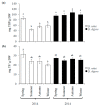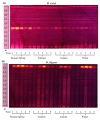Seasonal Changes in the Metabolic Profiles and Biological Activity in Leaves of Diospyros digyna and D. rekoi "Zapote" Trees
- PMID: 31731430
- PMCID: PMC6918230
- DOI: 10.3390/plants8110449
Seasonal Changes in the Metabolic Profiles and Biological Activity in Leaves of Diospyros digyna and D. rekoi "Zapote" Trees
Abstract
Leaves of semi-domesticated Diospyros digyna and wild D. rekoi trees, sampled seasonally in Mexico in 2014, were analyzed. Metabolic fingerprints revealed higher metabolite diversity in D. rekoi leaves. The TLC bands characteristic of glycosylated flavonoids, predominant in this species, matched the detection of quercetin and quercetin 3-O-glucuronides by liquid chromatography (UPLC-MS) of spring leaf extracts (LEs). Further gas chromatography (GC-MS) analysis revealed abundant fatty acids, organic acids, and secondary metabolites including trigonelline, p-coumaric, and ferulic and nicotinic acids. Phenolic-like compounds prevailed in D. digyna LEs, while unidentified triterpenoids and dihydroxylated coumarins were detected by UPLC-MS and GC-MS. A paucity of leaf metabolites in leaves of this species, compared to D. rekoi, was evident. Higher antioxidant capacity (AOC) was detected in D. digyna LEs. The AOC was season-independent in D. digyna but not in D. rekoi. The AOC in both species was concentrated in distinct TLC single bands, although seasonal variation in band intensity was observed among trees sampled. The AOC in D. digyna LEs could be ascribed to the coumarin esculetin. The LEs moderately inhibited phytopathogenic bacteria but not fungi. Leaf chemistry differences in these Mesoamerican Diospyros species substantiated previous variability reported in tree physiology and fruit physical chemistry, postulated to result from domestication and seasonality.
Keywords: Antioxidant capacity; Diospyros; flavonoid glycosides; metabolic fingerprints; phenolics; secondary metabolites.
Conflict of interest statement
The authors declare no conflict of interest.
Figures






References
-
- Provance M.C., García-Ruiz I., Thommes C., Ross-Ibarra J. Population genetics and ethnobotany of cultivated Diospyros riojae Gómez Pompa (Ebenaceae), an endangered fruit crop from México. Genet. Resour. Crop Evol. 2013;60:2171–2182. doi: 10.1007/s10722-013-0015-z. - DOI
-
- Pennington T., Sarukhán J. Árboles Tropicales de México. Manual Para la Identificación de las Principales Especies. Dirección General de Publicaciones y Fomento Editorial, UNAM; Mexico City, México: 2005. p. 523.
-
- Wallnöfer B. A revisión of neotropical Diospyros (Ebenaceae) part 1. Ann. Nat. Mus. Wien. 2007;108:207–247.
-
- García-Díaz R., Cuevas J.A., Segura S., Basurto F. Panbiogoegraphic analysis of Diospyros spp. (Ebenaceae) in Mexico. Rev. Mex. Cienc. Agric. 2015;6:187–200.
Grants and funding
LinkOut - more resources
Full Text Sources
Miscellaneous

